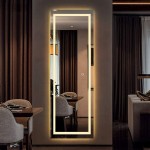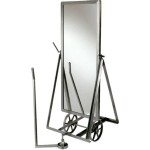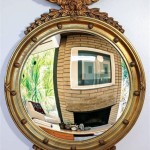How To Hang A Bathroom Mirror On Drywall
Hanging a bathroom mirror is a common home improvement task that can instantly enhance the aesthetics and functionality of the space. While seemingly straightforward, successfully mounting a heavy mirror on drywall requires careful planning, appropriate tools, and proper techniques. Failure to do so can result in the mirror falling, causing damage to the mirror itself, the wall, and potentially even injury. This article provides a comprehensive guide on how to securely hang a bathroom mirror on drywall.
Before embarking on the installation process, it is crucial to understand the inherent limitations of drywall. Drywall, also known as gypsum board, is a relatively fragile material. It is primarily composed of gypsum plaster sandwiched between two layers of paper. While drywall is easy to cut and install, it lacks the inherent strength to support significant weight on its own. Therefore, relying solely on drywall anchors for heavier mirrors is often inadvisable and can lead to future problems.
Identifying Stud Locations and Their Importance
The most secure method for hanging a bathroom mirror on drywall involves anchoring it directly into the wall studs. Wall studs are vertical framing members that provide structural support for the walls. They are typically made of wood and are spaced 16 or 24 inches apart on center. Locating and utilizing these studs significantly increases the weight-bearing capacity of the installation. To locate studs, a stud finder is an indispensable tool. Stud finders utilize either electronic sensors or magnetic principles to detect the presence of a stud behind the drywall.
Electronic stud finders typically scan for changes in density behind the wall. When the sensor passes over a stud, the density increases, triggering an alert. Magnetic stud finders, on the other hand, detect the nails or screws that are used to attach the drywall to the studs. Regardless of the type of stud finder used, calibration is essential for accurate readings. Before using the stud finder, consult the manufacturer's instructions for proper calibration techniques. Some stud finders also have settings for detecting electrical wiring or metal pipes, which can be helpful in avoiding potential hazards during the installation process.
Once a stud is located, it is crucial to verify its position. The stud finder might provide a general area, but pinpointing the precise center is essential for secure anchoring. A small nail or screw can be used to probe the area, confirming the presence of solid wood behind the drywall. If the nail or screw encounters resistance, it likely indicates the presence of a stud. If the nail or screw penetrates easily without resistance, it likely indicates that it is only passing through drywall. Mark the center of the stud clearly with a pencil. Repeat this process for each stud that will be used for mounting the mirror.
If it is not possible to locate studs in a suitable location for hanging the mirror, alternative methods using drywall anchors must be considered. However, it is important to carefully assess the weight of the mirror and choose anchors that are rated for the appropriate weight load. Overestimating the weight and selecting anchors with a higher weight capacity is always recommended to ensure a safe and secure installation. Always consult the manufacturer's specifications for the weight rating of the chosen anchors.
Selecting Appropriate Hardware for Drywall Installation
Choosing the right hardware is critical for securely hanging a bathroom mirror on drywall. The hardware consists of drywall anchors, screws, and potentially additional supporting components such as hanging wire or D-rings depending on the mirror’s design. The selection process is primarily driven by the weight of the mirror and the type of drywall anchor being used.
Several types of drywall anchors are available, each with varying weight capacities and installation methods. Toggle bolts are among the strongest drywall anchors, offering high weight-bearing capabilities. They consist of a bolt and a spring-loaded wing that expands behind the drywall, providing a secure hold. Molly bolts are another type of anchor that expands behind the drywall as the screw is tightened. They also offer good weight capacity, but are generally not as strong as toggle bolts. Self-drilling drywall anchors are easy to install, as they require no pre-drilled holes. However, they typically have lower weight capacities compared to toggle bolts and molly bolts. Plastic anchors are the most common and least expensive type, suitable only for very lightweight mirrors.
For heavier mirrors, toggle bolts are the preferred choice when studs are not accessible. When using toggle bolts, it is essential to drill holes large enough to accommodate the wings of the toggle. Once the wings are inserted behind the drywall, they will expand and provide a secure anchor point. Ensure the bolt is long enough to pass through the mirror's mounting hardware, the drywall, and the expanded toggle. For lighter mirrors, molly bolts or self-drilling anchors can be used. However, it is crucial to choose anchors with a weight capacity that exceeds the weight of the mirror to ensure a margin of safety.
The screws used to attach the mirror to the anchors should be of appropriate length and gauge. The screw length should be sufficient to securely engage with the anchor and the mirror's mounting hardware. The screw gauge should be appropriate for the size of the anchor and the weight of the mirror. Using screws that are too short or too thin can compromise the security of the installation. In general, using screws that are specifically designed for drywall anchors is advisable, as they typically have a coarser thread pattern that provides a better grip in drywall.
For mirrors that utilize hanging wire or D-rings, ensure that the wire is strong enough to support the weight of the mirror. Steel wire is generally recommended for heavier mirrors. The D-rings should be securely attached to the back of the mirror using screws or bolts that are appropriate for the material of the mirror's frame. Consider using additional reinforcement for D-rings on heavier mirrors to prevent them from pulling out over time.
The Mirror Hanging Procedure: Step-by-Step Instructions
Once the proper tools, hardware, and stud locations (or alternative anchor points) have been identified, the actual hanging process can commence. The process will differ slightly depending on whether studs are being used, or if reliance is placed on drywall anchors. It is helpful to have an assistant to assist when actually lifting and positioning the mirror, especially for heavier models.
With the stud location identified, mark the desired location for the mirror on the wall. Use a level to ensure that the marks are horizontally aligned. If the mirror has pre-drilled mounting holes, align the mirror with the marked locations and mark the hole positions on the wall. If the mirror does not have pre-drilled holes, measure the distance between the mounting hardware on the back of the mirror and transfer these measurements to the wall. Always double-check the measurements before drilling any holes.
Using a drill with a drill bit that is slightly smaller than the diameter of the screws, pre-drill pilot holes at the marked locations on the studs. Pre-drilling pilot holes makes it easier to drive the screws into the studs and prevents the wood from splitting. For drywall anchors, follow the manufacturer's instructions for drilling the appropriate size holes. Some self-drilling anchors do not require pre-drilled holes. Insert the drywall anchors into the pre-drilled holes. For toggle bolts, fold the wings and insert them through the hole in the mirror's mounting hardware, then push them through the pre-drilled hole in the drywall. For molly bolts, insert the bolt through the mirror's mounting hardware and then insert the bolt into the anchor.
Carefully lift the mirror and align the mounting holes with the pre-drilled pilot holes in the studs or the installed drywall anchors. Insert the screws through the mounting holes and tighten them until the mirror is securely attached to the wall. Do not overtighten the screws, as this can damage the drywall or the mirror's frame. Use a level to ensure that the mirror is perfectly level. Make any necessary adjustments by slightly loosening or tightening the screws. For toggle bolts, tighten the bolts until the wings are fully expanded behind the drywall. For molly bolts, tightening the bolt causes the anchor to expand behind the drywall, providing a secure hold. Double-check that the mirror is securely attached to the wall and that there is no movement or wobble. If the mirror feels loose, tighten the screws further or consider using larger drywall anchors.
Once the mirror is securely mounted, inspect the installation for any signs of damage or instability. Ensure that the mirror is level and that there are no gaps between the mirror and the wall. If necessary, touch up any scratches or blemishes with paint or caulk. Clean the surface of the mirror with a glass cleaner to remove any fingerprints or smudges. Regularly inspect the mirror's mounting hardware and anchors to ensure that they remain secure over time. If any signs of loosening or damage are detected, take corrective action immediately to prevent the mirror from falling.
By adhering to these guidelines, anyone can successfully and safely hang a bathroom mirror on drywall. Careful planning, appropriate tool selection, and proper installation techniques are the cornerstones of a secure and aesthetically pleasing result.

How To Hang A Heavy Mirror Diy Family Handyman

How To Install A Mirror Without Frame Merrypad
How To Hang A 100 Pound Mirror On Drywall Quora

Install A Recessed Vanity Mirror

How To Install A Mirrorchic Bathroom Mirror Frame Momhomeguide Com

Install A Recessed Vanity Mirror

How To Hang A Heavy Mirror On Drywall

Mounting A Mirror On Drywall Top 8 Ways For Savvy Handyman

How To Hang A Large Or Heavy Mirror

How To Hang A Heavy Mirror On Drywall








